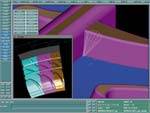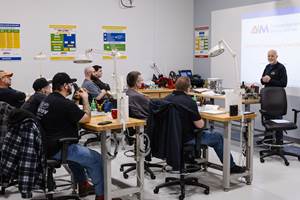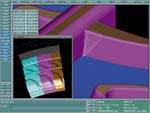Five-Axis CAD/CAM Integration Helps Optimize Moldmaker’s Machine Utilization
Continual improvements to its business processes, coupled with aggressive training programs and investments in state-of-the-art 5-axis machining technology, has allowed Prospect Mold to bolster its success in the aerospace and automotive markets.
Prospect Mold & Die Inc. (Cuyahoga Falls, OH) can trace its roots back to 1945, and has grown to be one of the largest moldmaking facilities in North America. The company serves a wide range of industries including mold/die design and build for the automotive industry; and, production part and custom tool design and build for the aerospace industry. Continual improvements to its business processes, coupled with aggressive training programs and investments in state-of-the-art 5-axis machining technology, has allowed Prospect Mold to bolster its success in the aerospace and automotive markets.
Mark Gruic, Data Coordinator at Prospect Mold says, “We have been using WorkNC CAM software since the late 80s. It was the first in the market and its toolpaths are phenomenal. Since then, we have been adding more seats, all of which we use on the shop floor.”
Designs are created in UG-NX and Catia V5. Every component of the design is released from Engineering to the Manufacturing group through the use of propriety PLM software developed and maintained by Prospect Mold. The data is then imported into WorkNC-CAD for shop floor programming. Gruic continues, “For example, the machine operators can turn off layers to remove water lines and do a little bit of surfacing to block ejector pin holes or fill gaps in the model. WorkNC-CAD does everything we need, is easy to use and is completely integrated with the WorkNC CAM software.”
Currently Prospect Mold has nine 5-axis CNC machines with plans to increase capacity in the near future. Cutting metals and a variety of composite materials has been achieved through Work NC’s 5-axis licenses. The operators use the dedicated 5-axis CNC commands in WorkNC software for cutting complex mold and die configurations and for cutting a variety of aerospace production parts and tools. Collision avoidance and simulation within the 5-axis CAM software take account of the limits of each machine, introducing flip and unwind movements where necessary to ensure safe and reliable toolpaths are always created.
Gruic adds, “We work two shifts, preparing most of the WorkNC CNC programs during the day and batch process long calculations overnight. We merge multiple programs so that the machines can run unattended. WorkNC is absolutely reliable, enabling us to operate unmanned with confidence.”
Program preparation in WorkNC is virtually automatic for the company. Sequence files or templates for similar jobs contain all the operations and tooling already set up. The operators simply need to load the new geometry and programming is complete. Not only does this greatly reduce the time required to produce a program, but it ensures that consistent machining methods are being used which, in turn, guarantees quality and delivers predictable cycle times.
Using WorkNC CAM software on the shop floor makes the best use of the operators’ skills and increases flexibility. Gruic elaborates, “We can transfer WorkNC stock models between operators so that a re-roughing or finishing operation can use the model created by a previous operation as a starting point. This eliminates air cutting as WorkNC knows exactly where the material is located. We can also rapidly move jobs to another machine, which simplifies scheduling and optimizes machine tool utilization and productivity. Furthermore, operators can program while the machines are cutting, which makes them far more efficient and improves job satisfaction levels.”
Gruic concludes, “We will continue to invest in more 5-axis WorkNC licenses as our 5-axis CNC machining requirements grow. We are also looking forward to implementing the next 64-bit and parallel processing version of the software, which will speed up calculation times even more. The benefits of WorkNC to Prospect Mold are phenomenal—we monitor our machine utilization levels and we consistently spend 80 percent of our time cutting metal.”
Related Content
MMT Chats: It’s Time to Play … The Moldmaker Card Game! Yes, a Game to Educate and Entertain
MoldMaking Technology Editorial Director Christina Fuges connects with Professor Steffen Ritter from Reutlingen University in Germany about the card game for moldmakers he developed to help promote and educate our next generation of moldmaking professionals in a fun way. This episode is brought to you by ISCAR with New Ideas for Machining Intelligently.
Read MoreMold Maintenance Continues to Matter: Enhanced Training Program in a New Facility
I attended a MoldTrax mold maintenance workshop in 2019 and shared my experiences, and despite changes in ownership, the workshop's remarkable value endures, as discussed in a recent Q&A with the current leadership.
Read MoreThe Ins and Outs of Hot Runner Temperature Control
A training checklist that explains the why and how of proper hot runner temperature control and system management.
Read MoreHow to Foster Innovation Through a Culture of Education, Mentoring
Dynamic Tool Corp. shares its strategy for building a team with the right attitude and aptitude to deliver innovation that meets customer expectations.
Read MoreRead Next
Five-Axis Mold Making Software Keeps Tires Rolling
Unless it goes flat, a tire is something most of us take for granted. In fact, the process of making a tire is very specialized and is becoming more sophisticated all the time.
Read MoreHow to Use Strategic Planning Tools, Data to Manage the Human Side of Business
Q&A with Marion Wells, MMT EAB member and founder of Human Asset Management.
Read MoreAre You a Moldmaker Considering 3D Printing? Consider the 3D Printing Workshop at NPE2024
Presentations will cover 3D printing for mold tooling, material innovation, product development, bridge production and full-scale, high-volume additive manufacturing.
Read More






.jpg;maxWidth=300;quality=90)














